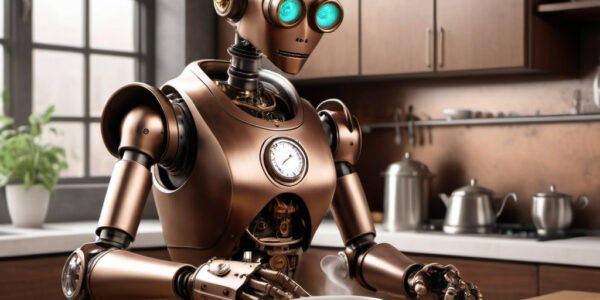“As I stood in the doorway, a strange metallic voice intoned, ‘Would you like a cup of tea, master?’ and a long metal arm with some kind of teapot-shaped device on the end hurled a glittering stream of steaming water up the walls. People were dodging frantically, colliding with each other, shrieking, ‘Switch it off. Switch it off, for God’s sake.’
In the centre of the room, Professor Penrose was wrestling with what looked like some sort of control box. Wires hung from the contraption and a giant aerial protruded from the front. Never mind the boiling water, he’d have someone’s eye out if he wasn’t careful.
In the meantime, Markham’s proto-assistant – well on its way to its first formal warning, as far as I could see – was still orbiting the room drenching everything in its path.
‘Would you like a cup of tea, master?’
‘I can’t think what’s gone wrong,’ cried Professor Penrose, a phrase not infrequently uttered in R&D. Glasses askew, he stabbed at random controls apparently without any effect whatsoever. The thing continued to career towards its future employer, knocking glassware off the tables and drenching everything in sight in its single-minded determination to provide Markham with a hot beverage.
Miss Lingoss strode across the room and yanked a plug from the wall.
‘Would you liiiiiiiiiiiiiiiiiii . . . ?’
Silence.
Everyone sighed with relief.
This is an excerpt from the tea-making robot scene in Jodi Taylor’s Plan for the Worst, part of the St. Mary’s time travel series.
This robot was not the boon to its makers that they expected it to be.
Japanese robot maker Docomo showed a tea-making robot at MWC23 last year. It was a remotely controlled robot, able to mimic the movements of a human being standing nearby, pretending to make tea. The makers claim that the human actions can be recorded so that, in theory, the robot could follow along once and then make tea on its own from that point on, but Docomo didn’t demonstrate that.
There’s also teaBOT, which is essentially a tea kettle with complicated programming options. It will not bring you a cup of tea. You have to go to it — in a shopping center, apparently — and use the touchpad to order a cup of tea, much as you would with a vending machine.
In fact, all the real-life tea-making robots we could find are basically a variant on a Nespresso machine: a tea kettle or a coffeepot or a vending machine. Nothing actually can make a cup of tea and bring it to you so you don’t miss the denouement of the movie you’re enjoying.
The tea test of intelligence
Alan Winfield wrote about tea-making as an excellent test of robot intelligence. He broke down the task, from finding the kettle and filling it with water to finding the tea bag to pouring the boiling water and brewing the tea to carrying the cuppa to the human being, and concluded that at this point it’s way too hard for any robot.
“One of the hard lessons of Artificial Intelligence that the things we thought would be difficult 60 years ago have turned out to be (relatively) easy, like playing chess, but the things we thought would be easy – like making a cup of tea – are still far from solved,” says Winfield. “Chess playing AIs are examples of narrow (single function) AI, whereas making a cup of tea in an unknown kitchen requires a wider set of general skills, that we lump together as ‘common sense’.”
Until robots have that, we’ll have to be thankful that we can pause the movie while we go make our own cup of tea.
